Eco-cement
Post from EditorialsAt the beginning the eco-cement was used to cover floors, stairs, walls of specificenvironments. More and more often now it also covers pieces of furniture and accessories.
Coat the surface with the eco-cement
Eco-cemento is a material for coating, a special finish that, started as a finish in the construction field, in recent years is becoming increasingly popular among those employed in the production of many pieces of furniture. At the beginning has been it was used to coat horizontal and vertical surfaces, especially floors, stairs, walls of specific environments.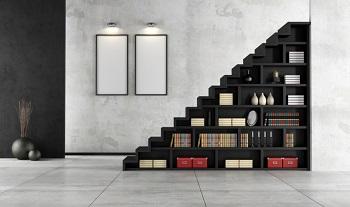 As a result, given the interest of the public and the consequent success that this type of finish has achieved, manufacturers of components for furniture and complements for the furnishing of every room in the house have invested in production technologies in order to exploit this element also in their specific field.
As a result, given the interest of the public and the consequent success that this type of finish has achieved, manufacturers of components for furniture and complements for the furnishing of every room in the house have invested in production technologies in order to exploit this element also in their specific field.
That's so that each of them has privileged an aspect of the eco-cement rather than the another depending on, for example, if this compound, which has thus taken various names, servit is usefull to cover a piece of furniture in the bathroom, in the living room or in the kitchen.
In some cases, the components to be mixed to make the final material, have been changed, so as to take special finishes or more specific colors. Above all, the sealing surface of this coating has been improved, making it more powerful, in the case of the use of eco-cement in rooms such as the bathroom or the kitchen, where moisture or grease stains or corrosive liquids can create problems or restrict their use.
Eco-cement in the bathroom
Makro is one of the first manufacturers to have proposed in its collections a type of undermount bathtub, with a customizable design with the ability to be able to coat the item according to the taste or to resume the style of the surrounding space.
The bathtub model is called Wave, shaped rectangular basin incorporated into a structure of expanded polystyrene (EPS), a structural feature that, in fact, allows you to vary the shape and type. The Wave tank can be covered with various materials among the classical ones used in construction, or mosaic, porcelain, ceramic or resin, while the top can be Corian® Makril, glass and heat-treated wood.
From today Wave can also be coated in eco cement, thanks to advanced technology that allows you to have a durable and safe material even in a difficult environment as may be the bathroom, with different colors to give this item a distinctly contemporary style.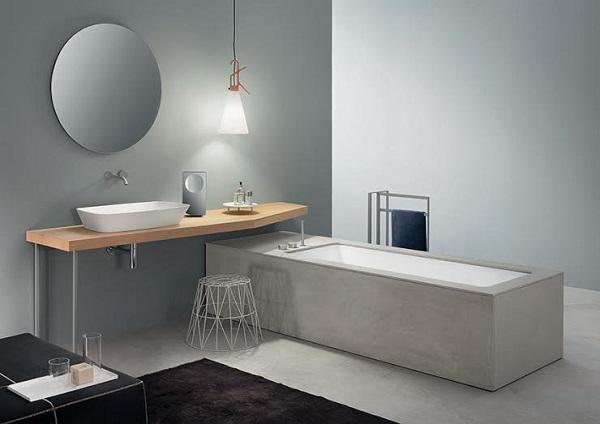
The eco-cement of Wave is a new finish consisting of a special natural water-based mixture, with concrete and fine granules to which was added an acrylic binder, applied on different products from the company. The different colors can be achieved with the addition of soils, oxides and colored pastes.
It is a material free of solvents and produces no emissions into the atmosphere. In addition, it can be reused up to exhaustion and it is not dangerous even during the various stages of processing. With regard to the application, then, is to say that the finish in eco-cement has a machining of more coats of spatula, to obtain a peach-skin effect due to the very fine grain. From here the original color variations, thanks to the light, playing with colors and light ripples left by the trowel, it creates very particular reflections.
Wave has an easy and fast installation, which reduces time and cost of construction. Like all the tubs by Makro, this ensures well-being and comfort thanks to the fact that almost manages to keep a constant water temperature. It is available in small, medium and large size.
Eco-cement in the kitchen
Then we have the applications in eco-cemento finish on the furniture for kitchens, after revisiting this material to make it suitable for this environment that, in terms of moisture problems has nothing to envy to the bathroom, indeed. In addition, in the kitchen also adds to the deleterious action of the vapors of acids and corrosive substances contained in cleaning products, or liquids such as coffee, cola, lemon juice and much more.
Very interesting, in this regard, is the kitchen model proposed by Dibiesse, Tratto, designed by Michele Marcon. Tratto hides a multitude of accessories, which have become indispensable, in one aspect of minimalism only apparent.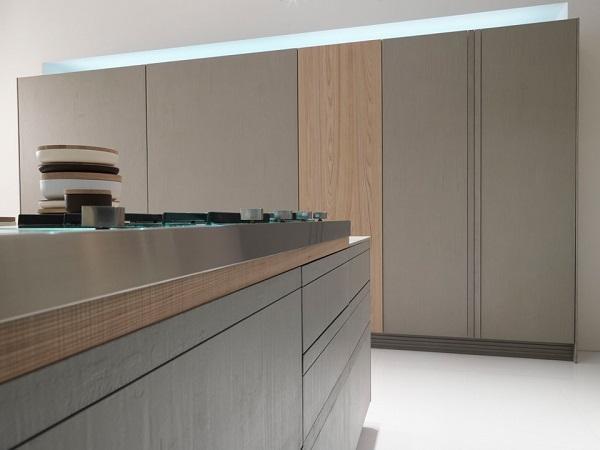
This cleaning of basic geometric shapes are enhanced by their finish in eco-cement. Both the cabinets and closets, and the top are covered by this material consisting of a special eco-mortar thin and breathable.
It is a material that can be applied on different surfaces, it is not brittle and it can be cleaned from oil and wax stains and dirt in general. The eco-cement Dibiesse is eco-friendly because being composed of non-toxic substances both for humans and for the environment.
Although this name is completely devoid of cement, lime, plaster and epoxy resins, is water-based and other materials to 100% of natural origin, is fire resistant and recyclable, and is applied by hand to keep the material effect. To enhance this finish, dulling the effect of cold at the same time of the eco-cemento, Tratto was presented in the catalog with entries in elm brushed finish.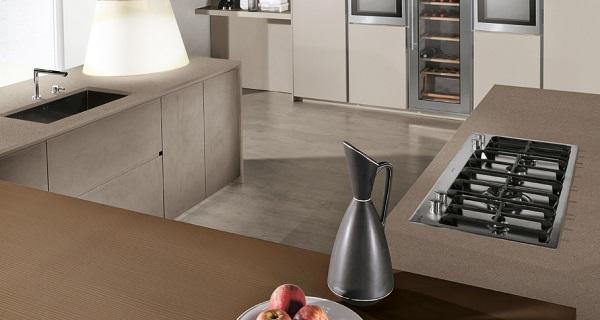
Also Maistri presented the new finish for Viva, one of the top models of the company, due to its extreme versatility. The cementina Maistri is a monolithic thick coating, made of synthetic emulsions and polymer mixed with natural minerals as the dust of Carrara marble, without solvents.
It is a water product and therefore it is not subject to phenomena of toxic fumes, in addition the action of the solar rays does not cause disruptions. It's very durable due to treatment with protective resins. The layer applyed by hand of the product produces a very particular materic effect.
Tables in eco-cement
Although the field of furnishing adds this type of finish among his current must-haves, because this coating, as already specified, is now offering guarantees that until some time ago were unthinkable, especially this is not a trivial matter.
If the resistance to scratches and wear and ease of cleaning are essential factors in the case of work plans, it will be the same way with regard to tables and side tables, which are also urged so from this point of view.
MDF Italy has in the catalog the table model Robin, in reality a program of tables of various sizes and shapes, 13 sizes in the rectangular version and 4 in square. Robin has rounded corners, round legs and concrete monochrome finish in the versions: natural concrete, charcoal cement, white lime cement, umber cement.
The floor has a thickness of 30 mm and consists of a panel made of a frame in profiled steel and filled in honeycomb resin with two layers of aluminum. The whole panel is laminated under high pressure to accommodate the surface application of the cement.
Since this is a finish applied by hand, the plans may have differences in the surface and in the shade, characteristics that demonstrate the uniqueness of each product. Furthermore, in addition to having, as for all versions, the normal stain resistant treatment, in the two natural and anthracite versions, the table Robin can also be used outdoor. 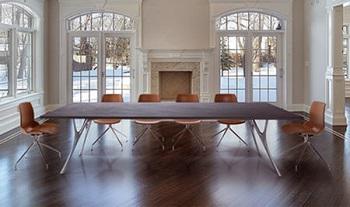 So much variety for the dimensional model Pegaso Cement by Caimi, made on a rigorous design to allow dimensions, also big ones. Its top is made of a composite panel structurally very light thanks to the sandwich type, ie with a core made of wood strips between two aluminum plates coated on top and at the sides in cement.
So much variety for the dimensional model Pegaso Cement by Caimi, made on a rigorous design to allow dimensions, also big ones. Its top is made of a composite panel structurally very light thanks to the sandwich type, ie with a core made of wood strips between two aluminum plates coated on top and at the sides in cement.
The precision of the top is softened by the sinuous support structure, in polished or painted aluminium.
79504 REGISTERED USERS










